Intellectual Property Rights
Foreword
Modal verbs terminology
Foreword
1 Scope
2 Reference
3 Definitions, symbols and abbreviations
3.1 Definitions
3.2 Symbols
3.3 Abbreviations
4 General
4.1 Relationship between minimum requirements and test requirements
4.2 Applicability of minimum requirements
4.3 Specification suffix information
4.4 Test points analysis
5 Operating bands and Channel arrangement
5.1 General
5.2 Operating bands
5.2A Operating bands for CA
5.2A.1 Intra-band CA
5.2A.2 Inter-band CA
5.2B Operating bands for DC
5.2B.1 General
5.2C Operating band combination for SUL
5.3 UE channel bandwidth
5.3.1 General
5.3.2 Maximum transmission bandwidth configuration
5.3.4 RB alignment with different numerologies
5.3.5 UE channel bandwidth per operating band
5.3.6 Asymmetric channel bandwidths
5.3A UE channel bandwidth for CA
5.3A.1 General
5.3A.2 Maximum transmission bandwidth configuration for CA
5.3A.3 Minimum guard band and transmission bandwidth configuration for CA
5.3A.4 RB alignment with Different Numerologies for CA
5.3A.5 UE channel bandwidth per operating band for CA
5.4 Channel arrangement
5.4.1 Channel spacing
5.4.1.1 Channel spacing for adjacent NR carriers
5.4.2 Channel raster
5.4.2.1 NR-ARFCN and channel raster
5.4.2.2 Channel raster to resource element mapping
5.4.2.3 Channel raster entries for each operating band
5.4.3 Synchronization raster
5.4.3.1 Synchronization raster and numbering
5.4.3.2 Synchronization raster to synchronization block resource element mapping
5.4.3.3 Synchronization raster entries for each operating band
5.4.4 TXŒRX frequency separation
5.4A Channel arrangement for CA
5.4A.1 Channel spacing for CA
5.4A.2 Channel raster for CA
5.4A.3 Synchronization raster for CA
5.4A.4 Tx-Rx frequency separation for CA
5.5 Configurations
5.5A Configurations for CA
5.5A.1 Configurations for intra-band contiguous CA
5.5A.2 Configurations for intra-band non-contiguous CA
5.5A.3 Configurations for inter-band CA
5.5B Configurations for DC
5.5C Configurations for SUL
6 Transmitter characteristics
6.1 General
6.2 Transmitter power
6.2.1 UE maximum output power
6.2.2 Maximum Power Reduction (MPR)
6.2.3 UE additional maximum output power reduction
6.2.4 Configured transmitted power
6.2A Transmitter power for CA
6.2B Transmitter power for DC
6.2C Transmitter power for SUL
6.2C.1 Configured transmitted power for SUL
6.2C.2 ?TIB,c
6.3 Output power dynamics
6.3.1 Minimum output power
6.3.2 Transmit OFF power
6.3.3 Transmit ON/OFF time mask
6.3.3.1 General
6.3.3.2 General ON/OFF time mask
6.3.3.3 Transmit power time mask for slot and [mini-slot] boundaries
6.3.3.4 PRACH time mask
6.3.3.5 PUCCH time mask
6.3.3.5.1 Long PUCCH time mask
6.3.3.5.2 Short PUCCH time mask
6.3.3.6 SRS time mask
6.3.3.7 PUSCH-PUCCH and PUSCH-SRS time masks
6.3.4 Power control
6.3.4.1 General
6.3.4.2 Absolute power tolerance
6.3.4.3 Power Control Relative power tolerance
6.3.4.4 Aggregate power tolerance
6.4 Transmit signal quality
6.4.1 Frequency error
6.4.2 Transmit modulation quality
6.4.2.1 Error Vector Magnitude
6.4.2.2 Carrier leakage
6.4.2.3 In-band emissions
6.4.2.4 EVM equalizer spectrum flatness
6.5 Output RF spectrum emissions
6.5.1 Occupied bandwidth
6.5.2 Out of band emission
6.5.2.1 General
6.5.2.2 Spectrum Emission Mask
6.5.2.3 Additional spectrum emission mask
6.5.2.4 Adjacent channel leakage ratio
6.5.2.4.1 NR ACLR
6.5.2.4.2 UTRA ACLR
6.5.3 Spurious emissions
6.5.3.1 General spurious emissions
6.5.3.2 Spurious emission for UE co-existence
6.5.3.3 Additional spurious emissions
6.5.4 Transmit intermodulation
7 Receiver characteristics
7.1 General
7.2 Diversity characteristics
7.3 Reference sensitivity
7.3.1 General
7.3.2 Reference sensitivity power level
7.3.2_1 Reference sensitivity level with 4 Rx antenna ports
7.3.3 ?RIB,c
7.3A Reference sensitivity for CA
7.3A.1 General
7.3A.2 Reference sensitivity power level for CA
7.3A.2.1 Intra-band contiguous CA
7.3A.2.1.0 Minimum requirements of reference sensitivity for CA
7.3A.2.1.1 Intra-band contiguous CA 2CC
7.3A.2.2 Intra-band non-contiguous CA
7.3A.2.3 Inter-band CA
7.3A.3 ?RIB,c for CA
7.3A.3.1 General
7.3A.3.2 Inter-band CA
7.3A.3.2.1 ?RIB,c for two bands
7.3A.3.2.2 ?RIB,c for three bands
7.3A.4 Reference sensitivity exceptions due to UL harmonic interference for CA
7.3B Reference sensitivity for DC
7.3C Reference sensitivity for SUL
7.3C.1 General
7.3C.2 Reference sensitivity power level
7.3C.3 ?RIB,c for SUL
7.3C.3.1 General
7.3C.3.2 SUL band combination
7.4 Maximum input level
7.4A Maximum input level for CA
7.5 Adjacent channel selectivity
7.5A Adjacent channel selectivity for CA
7.6 Blocking characteristics
7.6.1 General
7.6.2 Inband Blocking
7.6.3 Out-of-band blocking
7.6.4 Narrow band blocking
7.6A Blocking characteristics for CA
7.6A.1 General
7.6A.2 Inband blocking for CA
7.6A.2.1 Intra-band contiguous CA
7.6A.3 Out-of-band blocking for CA
7.6A.3.1 Intra-band contiguous CA
7.6A.4 Narrow band blocking for CA
7.7 Spurious response
7.8 Intermodulation characteristics
7.9 Spurious emissions
Annex A (normative): Measurement channels
A.1 General
A.2 UL reference measurement channels
A.2.1 General
A.2.2 Reference measurement channels for FDD
A.2.2.1 DFT-s-OFDM Pi/2-BPSK
A.2.2.2 DFT-s-OFDM QPSK
A.2.2.3 DFT-s-OFDM 16QAM
A.2.2.4 DFT-s-OFDM 64QAM
A.2.2.5 DFT-s-OFDM 256QAM
A.2.2.6 CP-OFDM QPSK
A.2.2.7 CP-OFDM 16QAM
A.2.2.8 CP-OFDM 64QAM
A.2.2.9 CP-OFDM 256QAM
A.2.3 Reference measurement channels for TDD
A.2.3.1 DFT-s-OFDM Pi/2-BPSK
A.2.3.2 DFT-s-OFDM QPSK
A.2.3.3 DFT-s-OFDM 16QAM
A.2.3.4 DFT-s-OFDM 64QAM
A.2.3.5 DFT-s-OFDM 256QAM
A.2.3.6 CP-OFDM QPSK
A.2.3.7 CP-OFDM 16QAM
A.2.3.8 CP-OFDM 64QAM
A.2.3.9 CP-OFDM 256QAM
A.3 DL reference measurement channels
A.3.1 General
A.3.2 DL reference measurement channels for FDD
A.3.2.1 General
A.3.2.2 FRC for receiver requirements for QPSK
A.3.2.3 FRC for maximum input level for 64QAM
A.3.2.4 FRC for maximum input level for 256 QAM
A.3.3 DL reference measurement channels for TDD
A.3.3.1 General
A.3.3.2 FRC for receiver requirements for QPSK
A.3.3.3 FRC for maximum input level for 64QAM
A.3.3.4 FRC for maximum input level for 256 QAM
A.4 CSI reference measurement channels
A.5 OFDMA Channel Noise Generator (OCNG)
A.5.1 OCNG Patterns for FDD
A.5.1.1 OCNG FDD pattern 1: Generic OCNG FDD Pattern for all unused REs
A.5.2 OCNG Patterns for TDD
A.5.2.1 OCNG TDD pattern 1: Generic OCNG TDD Pattern for all unused REs
Annex B (normative): Propagation Conditions
B.0 No interference
Annex C (normative): Downlink physical channels
C.0 Downlink signal levels
C.1 General
C.2 Setup
C.3 Connection
C.3.1 Measurement of Receiver Characteristics
Annex E (normative): Global In-Channel TX-Test
E.1 General
E.2 Signals and results
E.2.1 Basic principle
E.2.2 Output signal of the TX under test
E.2.3 Reference signal
E.2.4 Measurement results
E.2.5 Measurement points
E.3 Signal processing
E.3.1 Pre FFT minimization process
E.3.2 Timing of the FFT window
E.3.3 Post FFT equalisation
E.4 Derivation of the results
E.4.1 EVM
E.4.2 Averaged EVM
E.4.3 In-band emissions measurement
E.4.4 EVM equalizer spectrum flatness
E.4.5 Frequency error and Carrier leakage
E.4.6 EVM of Demodulation reference symbols (EVMDMRS)
E.4.6.1 1st average for EVM DMRS
E.4.6.2 Final average for EVM DMRS
E.5 EVM and inband emissions for PUCCH
E.5.1 Basic principle
E.5.2 Output signal of the TX under test
E.5.3 Reference signal
E.5.4 Measurement results
E.5.5 Measurement points
E.5.6 Pre FFT minimization process
E.5.7 Timing of the FFT window
E.5.8 Post FFT equalisation
E.5.9 Derivation of the results
E.5.9.1 EVMPUCCH
E.5.9.2 Averaged EVMPUCCH
E.5.9.3 In-band emissions measurement
E.6 EVM for PRACH
E.6.1 Basic principle
E.6.2 Output signal of the TX under test
E.6.3 Reference signal
E.6.4 Measurement results
E.6.5 Measurement points
E.6.6 Pre FFT minimization process
E.6.7 Timing of the FFT window
E.6.8 Post FFT equalisation
E.6.9 Derivation of the results
E.6.9.1 EVMPRACH
E.6.9.2 Averaged EVMPRACH
Annex F (normative): Measurement uncertainties and Test Tolerances
F.1 Acceptable uncertainty of Test System (normative)
F.1.1 Measurement of test environments
F.1.2 Measurement of transmitter
F.1.3 Measurement of receiver
F.2 Interpretation of measurement results (normative)
F.3 Test Tolerance and Derivation of Test Requirements (informative)
F.3.1 Measurement of test environments
F.3.2 Measurement of transmitter
F.3.3 Measurement of receiver
Annex G (normative): Uplink Physical Channels
G.0 Uplink Signal Levels
G.1 General
G.2 Set-up
G.3 Connection
G.3.0 Measurement of Transmitter Characteristics
G.3.1 Measurement of Receiver Characteristics
G.3.2 Measurement of Performance Requirements
Annex H (normative): Statistical Testing
H.1 General
H.2 Statistical testing of receiver characteristics
H.2.1 General
H.2.2 Mapping throughput to error ratio
H.2.3 Design of the test
H.2.4 Numerical definition of the pass fail limits
H.2.5 Pass fail decision rules
Annex I: Change history
History

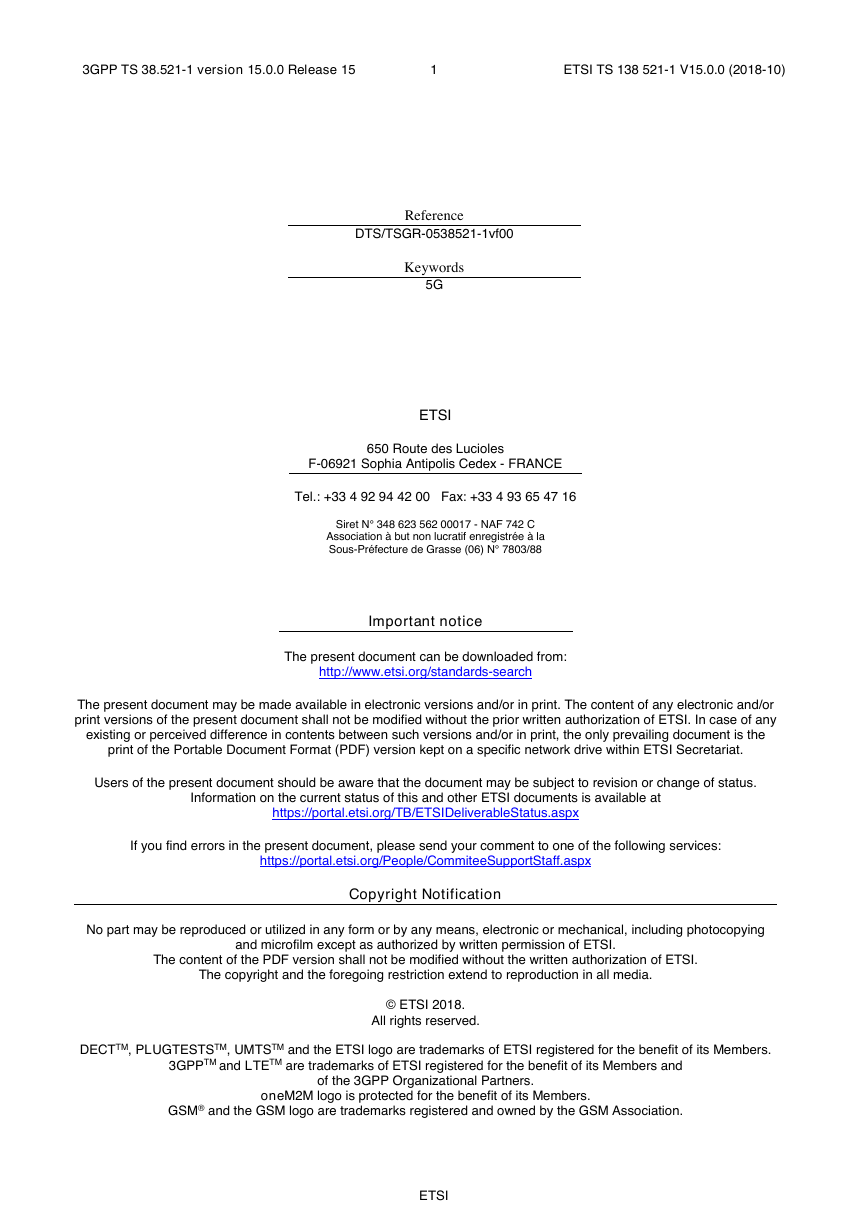
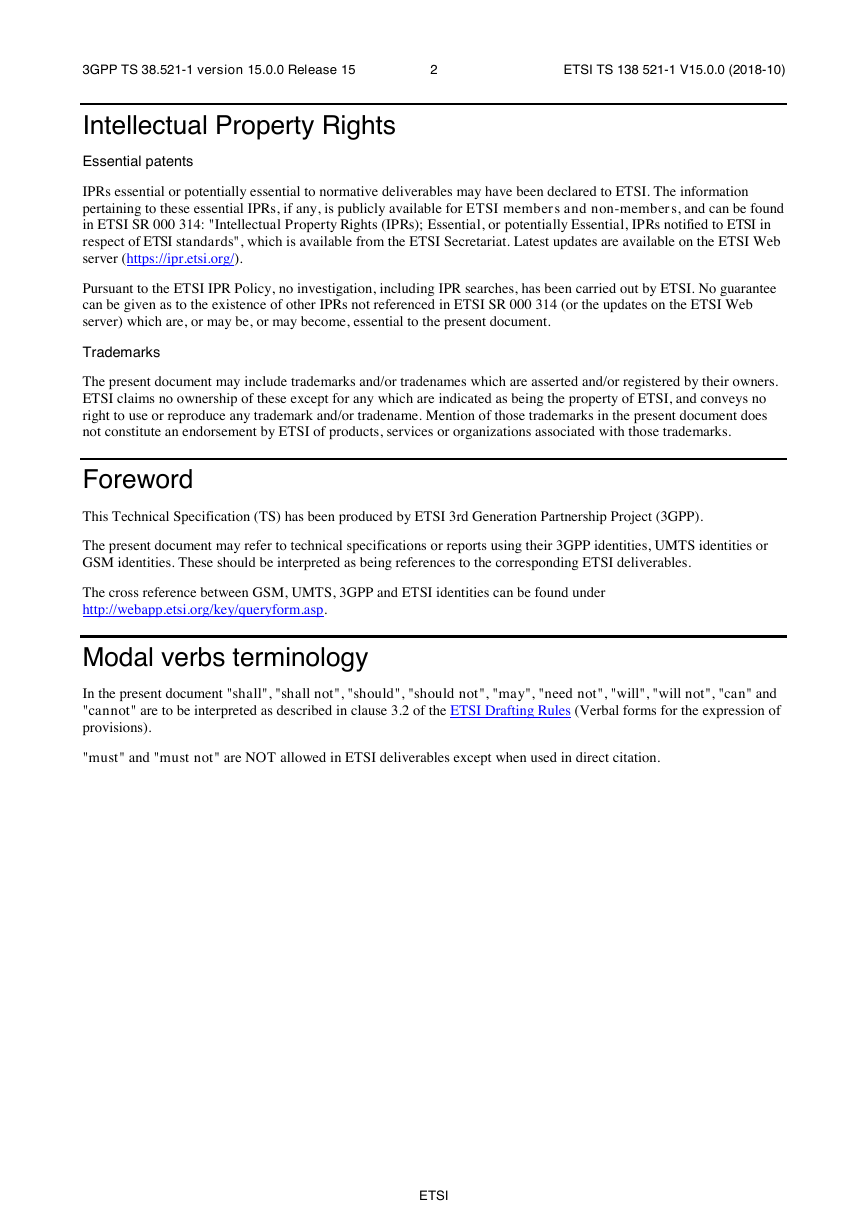
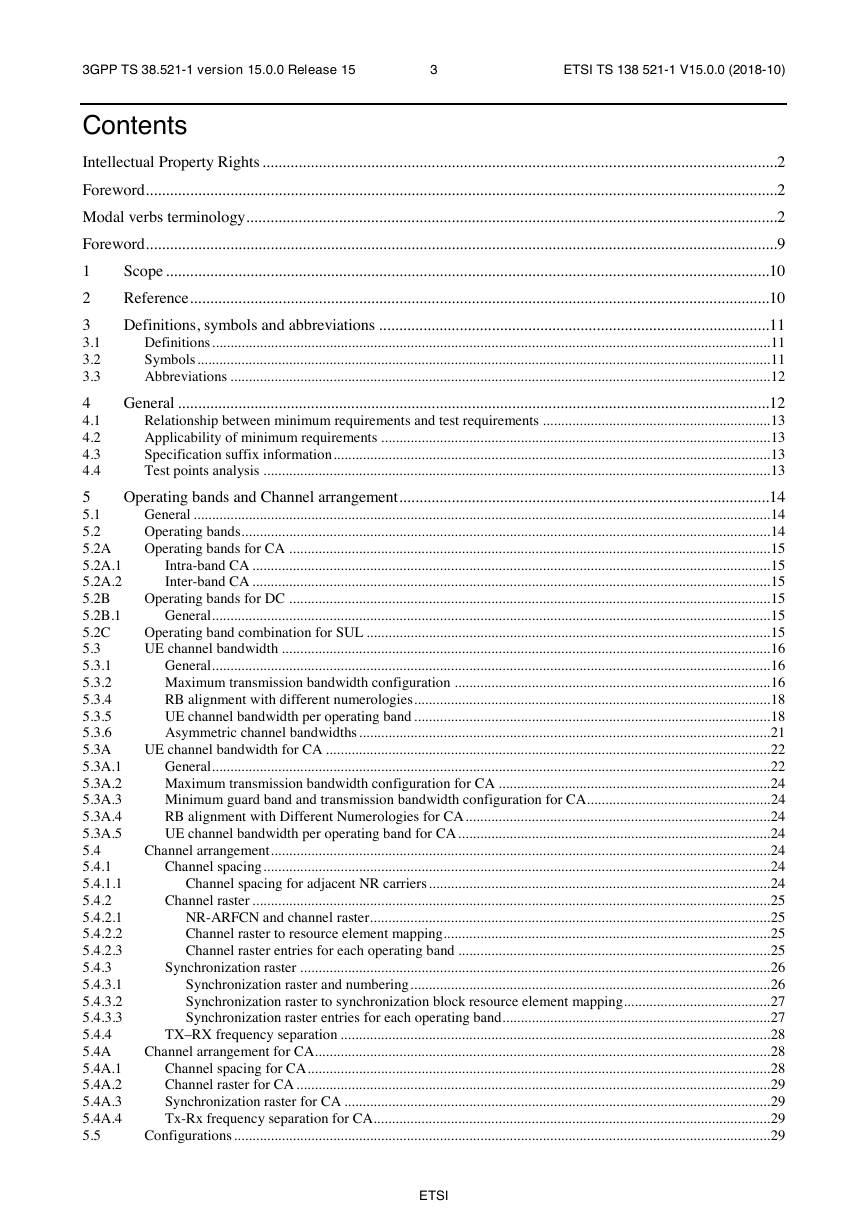
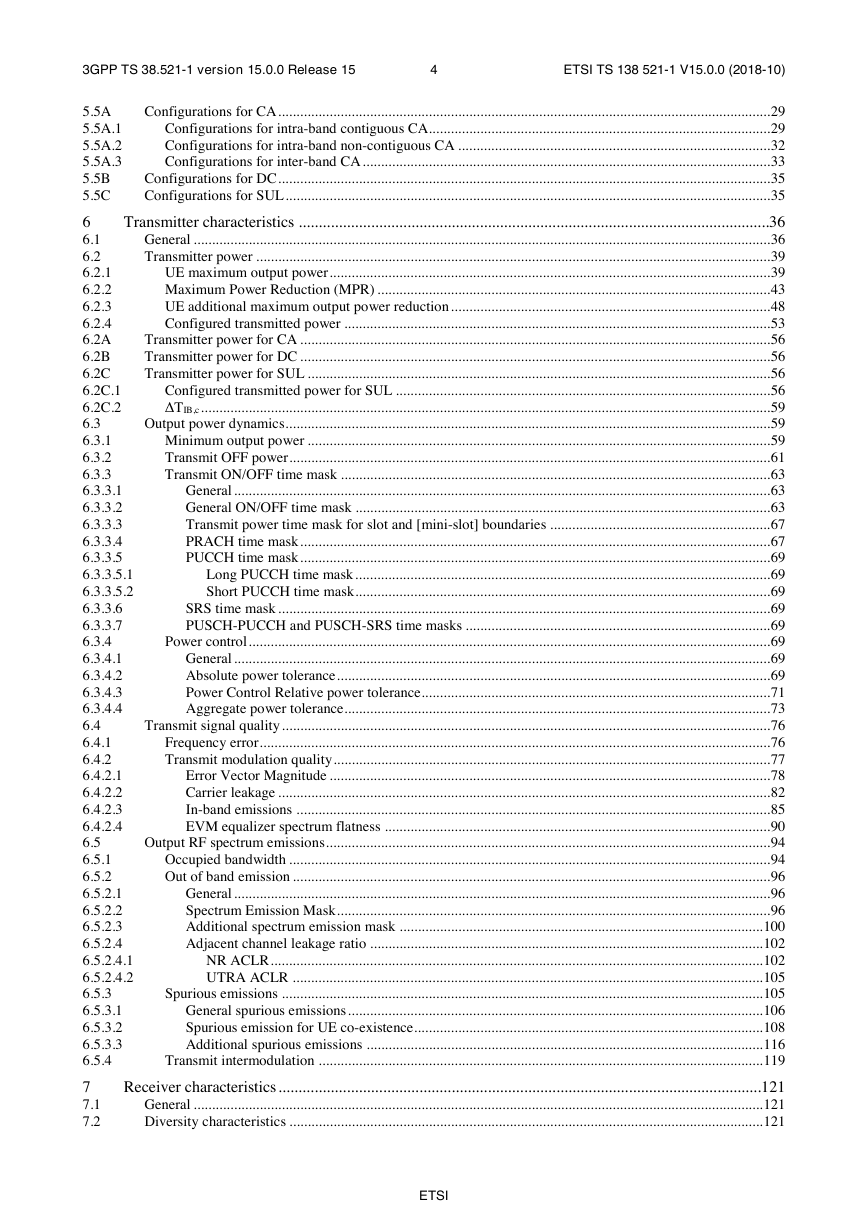
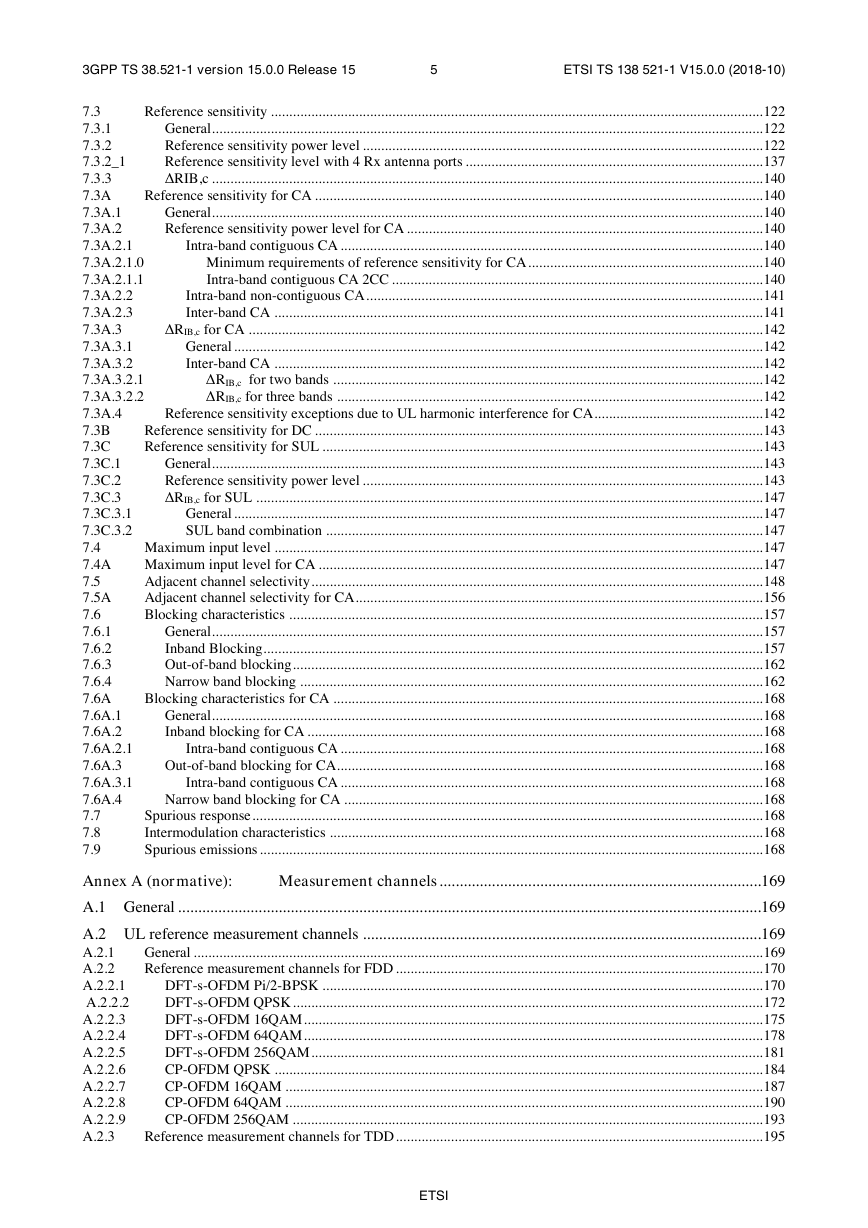
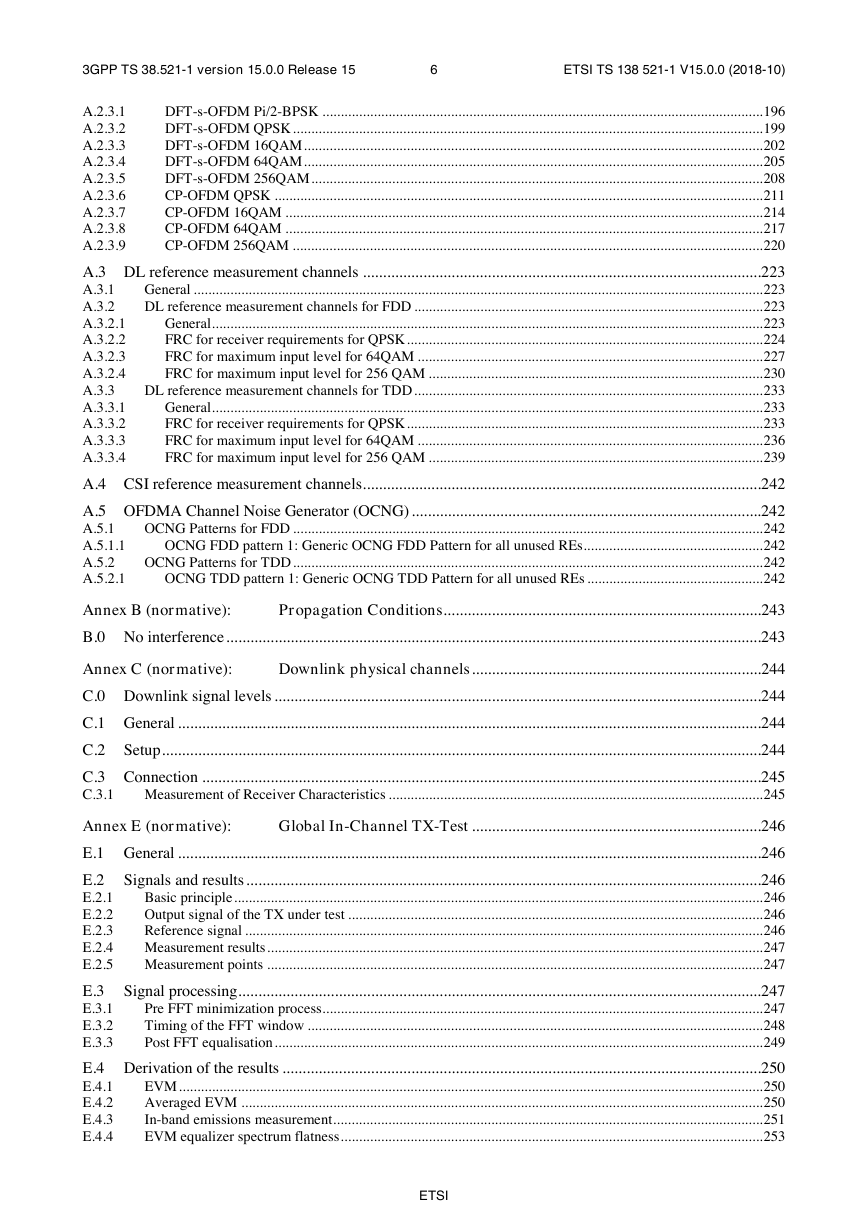
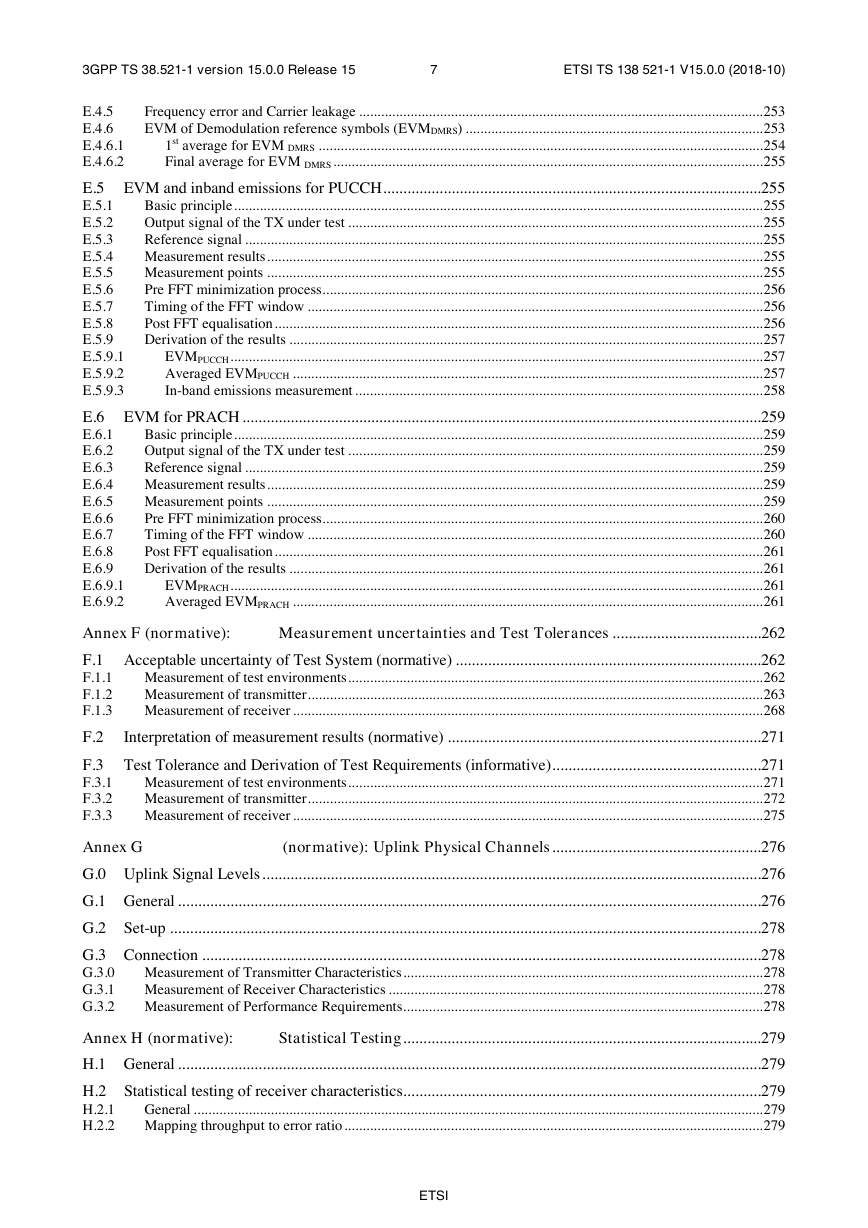








 2023年江西萍乡中考道德与法治真题及答案.doc
2023年江西萍乡中考道德与法治真题及答案.doc 2012年重庆南川中考生物真题及答案.doc
2012年重庆南川中考生物真题及答案.doc 2013年江西师范大学地理学综合及文艺理论基础考研真题.doc
2013年江西师范大学地理学综合及文艺理论基础考研真题.doc 2020年四川甘孜小升初语文真题及答案I卷.doc
2020年四川甘孜小升初语文真题及答案I卷.doc 2020年注册岩土工程师专业基础考试真题及答案.doc
2020年注册岩土工程师专业基础考试真题及答案.doc 2023-2024学年福建省厦门市九年级上学期数学月考试题及答案.doc
2023-2024学年福建省厦门市九年级上学期数学月考试题及答案.doc 2021-2022学年辽宁省沈阳市大东区九年级上学期语文期末试题及答案.doc
2021-2022学年辽宁省沈阳市大东区九年级上学期语文期末试题及答案.doc 2022-2023学年北京东城区初三第一学期物理期末试卷及答案.doc
2022-2023学年北京东城区初三第一学期物理期末试卷及答案.doc 2018上半年江西教师资格初中地理学科知识与教学能力真题及答案.doc
2018上半年江西教师资格初中地理学科知识与教学能力真题及答案.doc 2012年河北国家公务员申论考试真题及答案-省级.doc
2012年河北国家公务员申论考试真题及答案-省级.doc 2020-2021学年江苏省扬州市江都区邵樊片九年级上学期数学第一次质量检测试题及答案.doc
2020-2021学年江苏省扬州市江都区邵樊片九年级上学期数学第一次质量检测试题及答案.doc 2022下半年黑龙江教师资格证中学综合素质真题及答案.doc
2022下半年黑龙江教师资格证中学综合素质真题及答案.doc